Lotus block tutorial
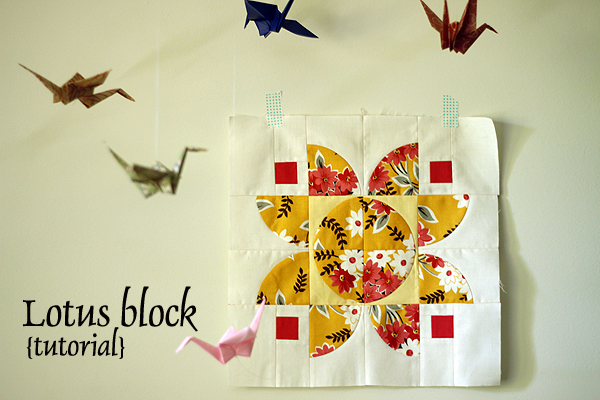
This is Part A of a 2-part tutorial. The 12" finished Lotus block is made with Drunkard's Path curves. Cut your curves with my downloadable Lotus DP template or with the Accuquilt 3.5" finished drunkard's path die See Planning your Lotus Quilt for more details on quilt-making considerations.
About Sewing Curves
Sewing patchwork curves is not so hard that anyone can't learn to do it. Like anything (even learning to sew straight seams!) it takes practice. If you've never sewn curves before, there's no time like the present to learn. I suggest you start by pinning your curves to understand how the pieces work together. Then try to sew them without pinning, just to see if that method suits you, since it does save a lot of time. You can search the internet for tutorials or videos about sewing Drunkard's Path blocks to see the process in action. Then, practice, practice, practice! Maybe start with some junk fabric to get your feet underneath you.
To make things easier, use the larger background template for the circle/surround D.P. blocks. You'll trim excess background after sewing your curves, which will help disguise mistakes while you get the hang of things.

Block Design
First acquaint yourself with the Lotus block parts:
Generally you will make some parts in the same fabric. For example, in the green block above, I used the same fabric for the surround and petal elements (Netorious in Jam Jar). In the orange block below on right, I used the same fabric for the circle and petal elements. In both cases you will need a fat eighth of fabric per block, whether doing the petal/surround combo OR the circle/petal combo! The green block style we'll call Block A; whereas, the orange block style we'll call Block B.
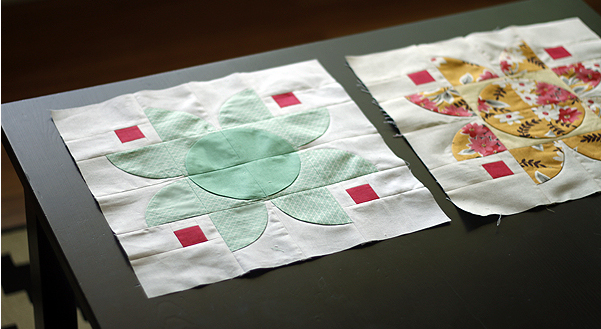
Cutting with Accuquilt Cutting Die
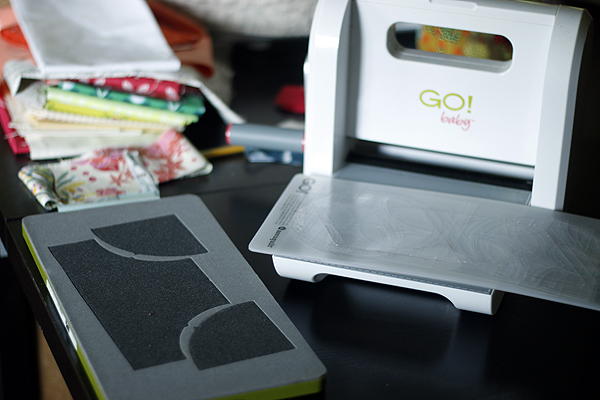
When using my cutter, I always run a double layer of fabrics through at once to save time!
for Block A
Contrast Circle: (4) 3.5" squares
Surround and Petals: (2) 5.5" x 10.5" and (4) 3.5" squares
Squares: (4) 1.5" squares
Background: 6.5" WOF strip (6.5" x 42")
If you are cutting the surround/petals from a fat eighth piece, cut as shown:
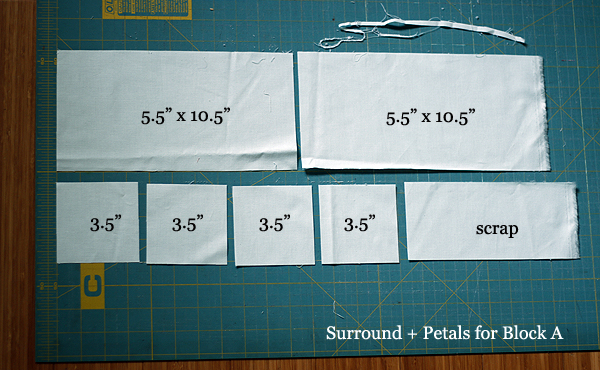
Place the 5.5" x 10.5" fabric pieces on the cutting die so that they completely cover the cutting area. I like to place my fabrics following the slant of the cutting area so that my straight cut edges are along the straight grain.

Run the cutting die through your Go! Baby cutter to yield both petal and surround pieces all at once. In addition, run all 3.5" squares through the cutter over the quarter-circle cutting element. Once all circle, surround and petal fabrics are cut, you should have (4) circles, (4) surrounds and (8) petals.
for Block B
Circle and Petals: (12) 3.5" squares
Contrast Surround: (2) 4.5" x 8.5"
Squares: (4) 1.5" squares
Background: 6.5" WOF strip (6.5" x 42")
If you are cutting the surround/petals from a fat eighth piece, cut (2) 3.5" strips and segment into (6) 3.5" squares per strip, yielding 12 total.
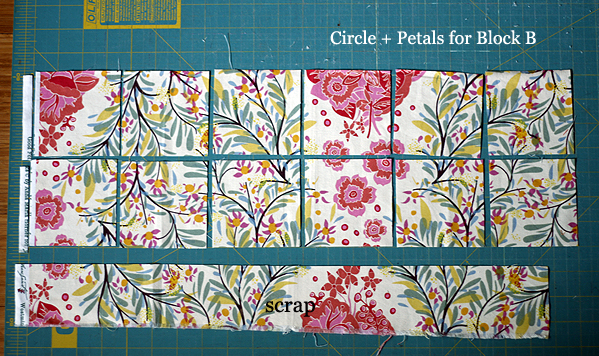
Run all 3.5" squares through the cutter over the quarter-circle cutting element. Place the 4.5" x 8.5" surround fabrics on the die cutter so that they cover the L-shaped cutting element. The partial quarter-circles are scraps.
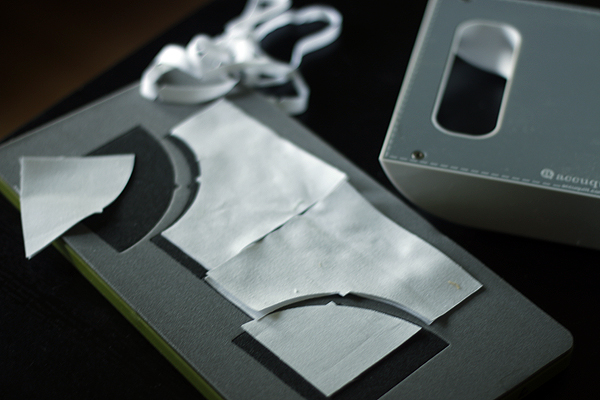
Once all circle, surround and petal fabrics are cut, you should have (4) circles, (4) surrounds and (8) petals.
Background for Blocks A or B
From your background fabric cut a 4.5" WOF strip and a 2" WOF strip.
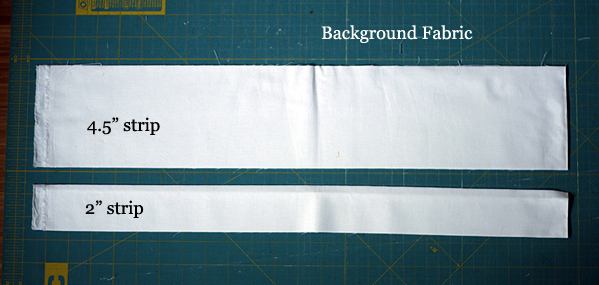
Keeping the strips double folded for speed, segment the 4.5" strip into:
(4) 4.5" x 8.5"
(4) 2.5" x 4" (OR 2.75" x 4.25" if you prefer to work with slightly oversized pieces so that the finished block can be trimmed to a tidy 12.5")
From the 2" strip, cut (4) 2" x 2.5" strip. The remainder of the 2" strip can be used for other blocks if you are using a consistent background, so that you only have to cut a 4.5" WOF strip of background next time.
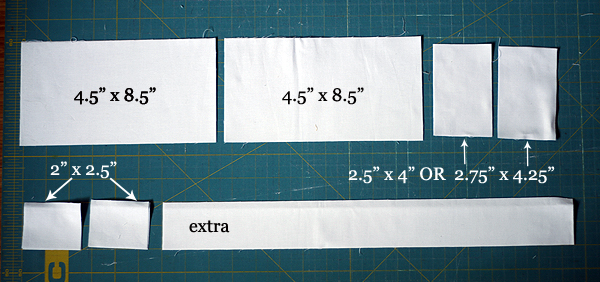
Run the 4.5" x 8.5" background cuts through the Go! Baby cutter over the L-shaped cutting elements. After using the die cutter, you'll have scrap partial quarter circles. From those background scraps cut (4) 1" x 1.5" and (4) 1" x 2". These tiny pieces will surround the 1.5" squares at the four corners of the block.
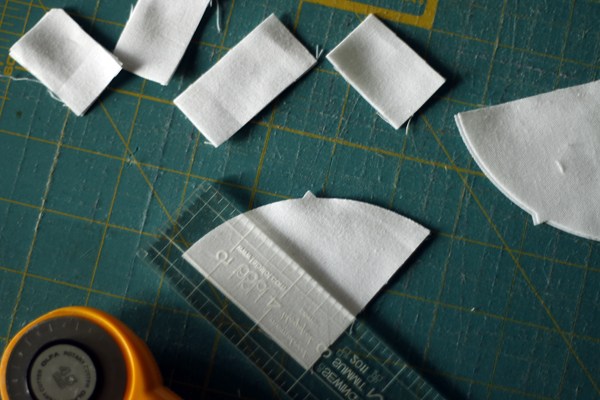
Cutting with Printable Templates
The template page has four shapes which make up two Drunkard's Path blocks. Each pair has a quarter-circle element and an L-shaped element. The upper pair has a thinner L-shape designed for the circle/surround part of the block; whereas the lower pair has a thick L designed for the petals/background part of the block.
If you are new to sewing curves or still struggling, cut the surround fabrics with the thicker L-shape and plan to trim away excess background after sewing your curves. This will increase block accuracy. You will need 4" squares for your surround fabrics in this case. Adjust tutorial as necessary.
for Block A
Contrast Circle: (4) 3" squares
Surround and Petals: (12) 3" squares
Squares: (4) 1.5" squares
Background: (8) 4" squares, (4) 2.5" x 4" (OR 2.75" x 4.25" if you prefer to work with slightly oversized pieces so that the finished block can be tidily trimmed), (4) 1" x 1.5" and (4) 1" x 2". These tiny pieces will surround the 1.5" squares at the four corners of the block.
for Block B
Circle and Petals: (12) 3" squares (4 for circles and 8 for petals)
Contrast Surround: (4) 3" squares
Squares: (4) 1.5" squares
Background: (8) 4" squares, (4) 2.5" x 4" (OR 2.75" x 4.25" if you prefer to work with slightly oversized pieces so that the finished block can be tidily trimmed), (4) 1" x 1.5" and (4) 1" x 2". These tiny pieces will surround the 1.5" squares at the four corners of the block.
Use the template pair with the thinner L-shape to cut circle and surround fabrics. The circle fabrics are cut with the quarter-circle shape, while the surround fabrics are cut with the thin L shape.
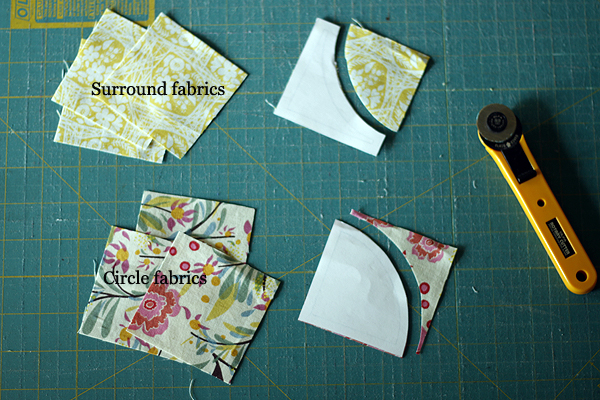
Use the template pair with the thicker L-shape to cut petals and background curves. The petals are cut with the quarter-circle shape, while the background curves are cut with the thick L shape out of 4" squares.
When you are finished you should have 4 circles, 4 surrounds, 8 petals, 8 background curves and misc. small background rectangular pieces.
Sew D.P. Curves
Sew together all of your Drunkard's Path blocks, matching circle pieces to surrounds and petals to background curves. Here I'm demonstrating on circle pieces being sewn to thin L-shaped surrounds, but the process is the same with a thick L-shape.
The L-shaped piece is the concave curve. As you feed the DP pair through your sewing machine, keep the L-shape on top for best results (as shown). On the left I've pinned a pair together (L-shape on top). On the right I'm ready to sew without pinning, starting my stitches where the pencil is pointing. I have matched this pair right sides together with the straight edges aligned at top (pencil side) and the curved raw edges also matched only where I'll start sewing.
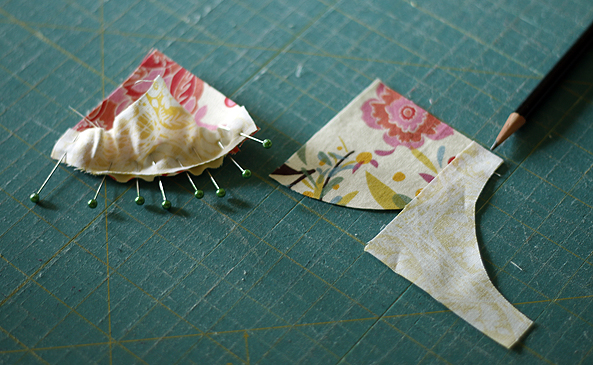
If you need to practice sewing curves, I suggest you start by pinning a few blocks to get used to the way the cut pieces relate. First fold your pieces in half to find the center of each curve. Finger press and release. Next match right sides together and arrange as shown below. Note that the straight outer edges are aligned and the curved raw edge also matches just at this corner. (This is the same formation one starts at when sewing without pins.) Place a pin to secure.
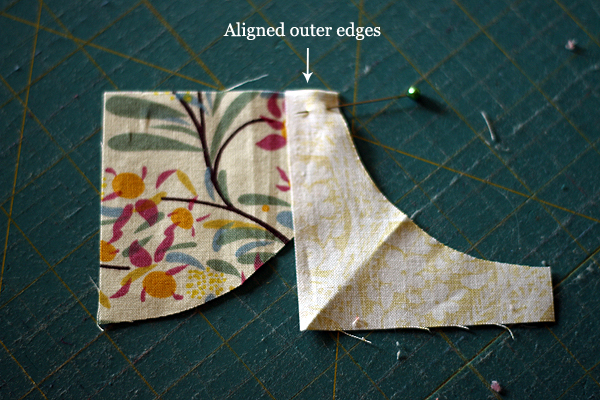
Now in the same way, match the opposite straight outer edge of the L-shape to the other end of the quarter circle (see arrow). At this point the fabric pieces will buckle apart from each other, but that's OK. Pin to secure.
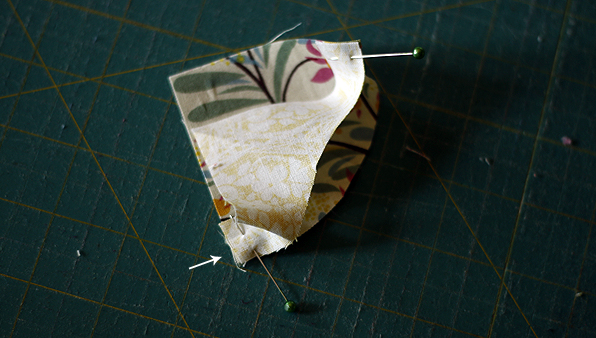
Next pin at the center of the curves where you finger pressed center on each piece.
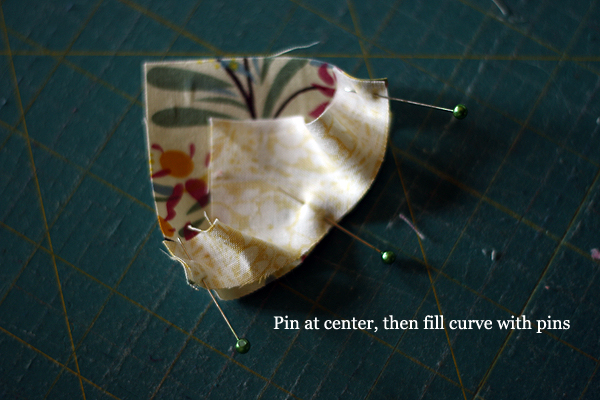
Now fill in the curve with pins throughout, distributing the fabric evenly. Go ahead and use lots of pins if you like! Then take the pair to your machine and sew slowly, removing pins as you go. Remember, sew with the L-shape on top. Sew with a 1/4" seam allowance right at the needle, keeping your attention focused on what is happening at the needle and just allowing the shape to rotate through.
After you've had some practice, you can experiment with sewing curves without pins. As you sew, you match up the raw edges of the curves just at the needle, not worrying about the fact that they are not matched up anywhere else.
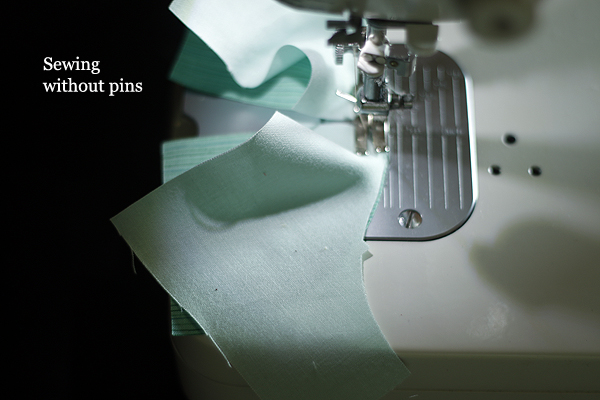
If you've cut your pieces with the Accuquilt die, each one has a little notch at center which you can match up while pinning or while feeding the pieces through the machine without pins.
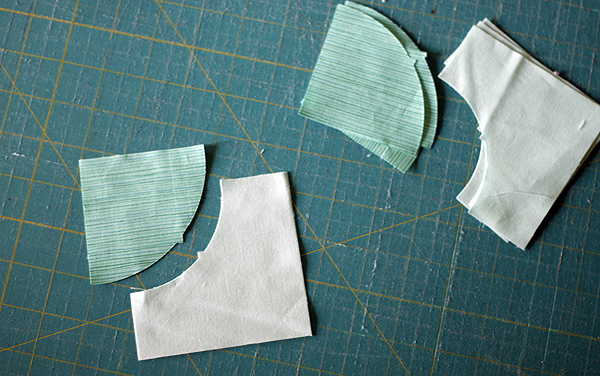
After sewing, press all seams towards the quarter-circle shape. No notching should be required.
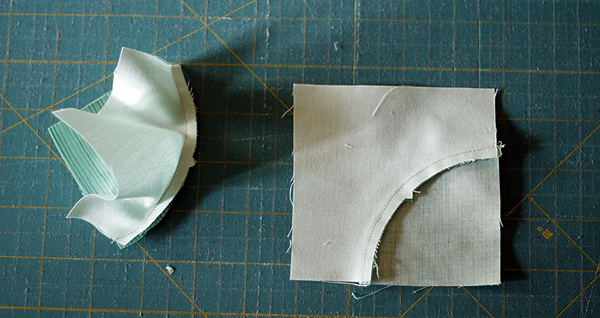
We'll continue to the next step, trimming your DP blocks, in Part B.
Cutting your fabrics and sewing your curves is the bulk of the work! Since this tutorial is rather lengthy go to Lotus Block Part B to learn how to trim your DP blocks, sew in the corner squares and assemble the block. Enjoy!

